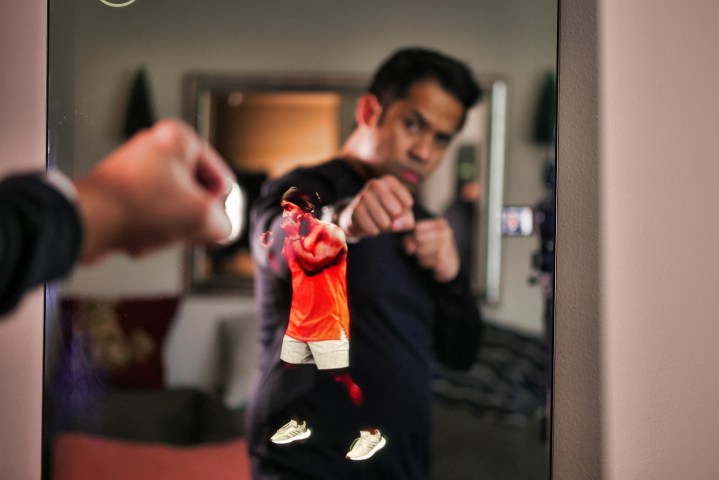Most home gyms require a large workout area, but that’s not the case with a smart mirror. these fitness devices provide access to hundreds of online fitness classes with a minimal footprint. Some mirrors are so stylish, you can mount them in your living room and they will blend right in. When shopping for a smart mirror, you’ll likely come across the Mirror and Tempo. Which one is better? We break down their strengths and weaknesses so that you can choose the best fitness mirror for you.
Hardware

The Tempo and the Mirror are more than just exercise equipment. They are showpieces that look great in any room. The Mirror is a chameleon. You wouldn’t even know it was a fitness mirror. When it is not in use, it looks exactly like a full-length mirror. Because it can mount on the wall, the Mirror takes very little space in your room.
The Mirror features a roomy 40-inch 1080p display, but it does not have a touchscreen. You control it using your smartphone and the Mirror app. Having to connect your phone is a significant drawback to using the platform. If you cannot find your phone or discover your phone’s battery is almost dead, you cannot start a workout.

The Tempo Studio has a similar compact and attractive design to the Mirror, but it sits on an easel and not on the wall. It is ideal for homeowners who don’t want a permanent installation or apartment dwellers who cannot drill into their walls. It blends easily into any room, but is not as discrete as the mirror.
Because it has a stand, Tempo takes up a bit more room and weighs more than the Mirror. Its stand doubles as a storage spot for the included weights. which is a significant space saver. Everything you need is stored in a single neat and compact package.
The Tempo is equipped with a 42-inch touchscreen display and sensors to track your form as you work out. This form tracking is helpful, but it pushes out the space requirements for workouts. You need to stand back about six feet from the fitness mirror for the sensors to work.
Workout library

Both the Tempo and Mirror offer a wide variety of classes for all levels of fitness. They both also offer live classes for those who want to replicate the gym experience. Regardless of which fitness mirror you choose, you will find plenty of exercises to get you started and ton sof others to keep you improving over time.
Both the Tempo and Mirror are continually adding new classes to their exercise libraries. When it comes to the sheer volume of exercises, Mirror is the clear winner. It has a more extensive library, with tens of thousands of classes. Mirror also offers 1:1 personal training that you can purchase outside of the monthly subscription. Each private class costs $40. Some may balk at this price, but others may welcome the opportunity to work directly with a professional trainer.
Mirror and Tempo also differ in the types of exercises that are available. Dumbbells, kettlebells, and similar weights are optional with the Mirror. The unit does not ship with these extras, and not everyone wants to invest in a set of bulky free weights. As a result, the bulk of Mirror’s exercise library uses body weight for strength and cardio training. This may change as Mirror expands its content to incorporate the company’s new smart weights. These weights track your form and add a new dimension to Mirror workouts. Tempo ships with weights by default and has a robust strength training component that makes it a bit more versatile than the Mirror.
Subscription

Both Mirror and Tempo require you to purchase a monthly membership, which provides access to the workouts that power these workout platforms. Without a membership, both Mirror and Tempo become glorified home decorations.
A membership to Mirror costs $39 per month, which includes accounts for up to six individuals. As mentioned, users also can purchase personal training sessions, which cost $40 per session. Mirror requires you to pay for a year, after which you can switch to a month-by-month subscription. Tempo also includes household members in the subscription price, allowing the whole family to work out. Tempo, like the Mirror, does require a 12-month commitment for the first year.
Hardware cost

At first glance, the Mirror appears to be the better deal with a price tag of $1,495 compared to $,2,495 for Tempo. Tempo may cost more, but it is actually the better deal, as it includes extras like an exercise mat, dumbbells, and a barbell with 75 pounds of plates. These extras make up the difference, both in cost and convenience. The Tempo comes with everything you need in one package. Once it is installed, you don’t need to buy anything else. With the Mirror, you need to purchase weights to do any strength training exercises. Mirror just unveiled new smart weights that track your form, ensuring you are working out properly.
The verdict
You cannot go wrong with either the Mirror or the Tempo. Both are stylish and fit the decor of every room. They are compact and require minimal space for installation and workouts. Both also offer a rich library of workouts for all abilities. When you get down to the nitty-gritty details, we’d recommend the Tempo for those who want to focus on free-weight strength training. The unit ships with weights and has a handy integrated cabinet for storing these accessories.
Not everyone wants to deal with bulky weights. They take up a lot of space in a room and are difficult to move. Those who prefer a simplified setup would do well with the Mirror. The Mirror offers everything from stretching to bodyweight strength training. With its vast library of classes, you will never run out of exercises to do. It’s also a less expensive than the Tempo, so you don’t break the bank while trying to bulk up.



